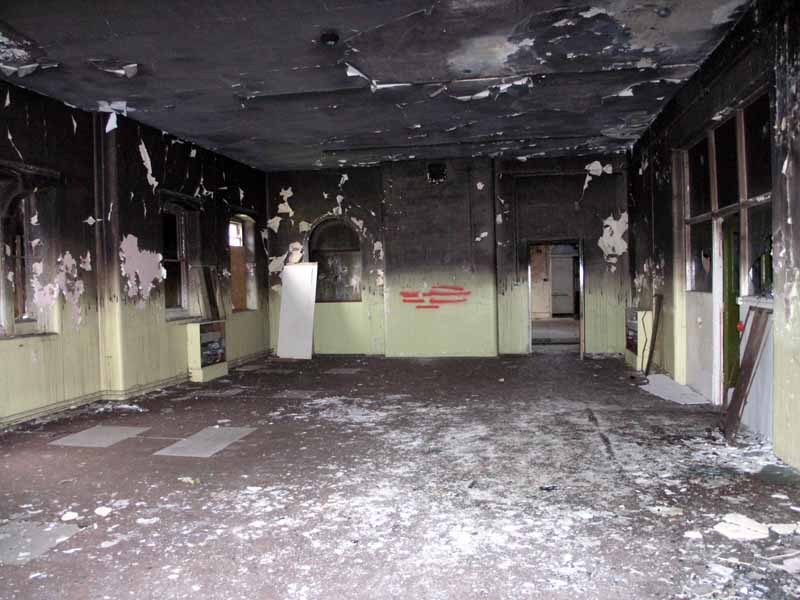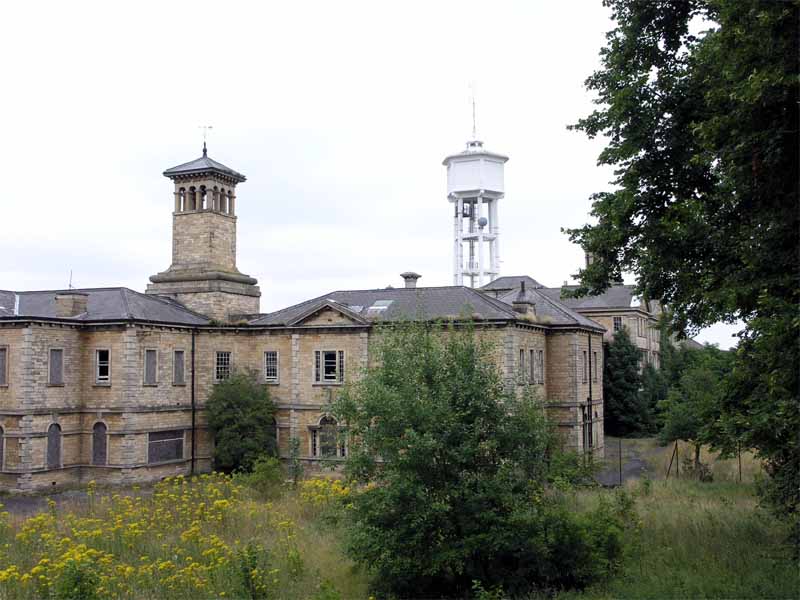|
I returned to the asylum on the 1st August to find the fence (mostly) repaired. Inside doors were newly fixed
and parts of the building were now inaccessible.
It was quite clear that the building was again being secured. This was confirmed by a loud banging and hammering
from the ward which suddenly occurred below us. Gingerly we made our way downstairs and managed to
escape, but I think we could’ve ended up being nailed up inside the buildings.
By coincidence, I received an e-mail from the building’s owners the next day. This is the first time the owners’
of a site have contacted me so please heed their warnings (see below).
© Simon Cornwell 2005
|

|
Asbestos at St John's Lunatic Asylum, Bracebridge Heath, Lincoln
I work for the company who have bought St John's and have had
some trouble there over the last few days with 'youths' traveling to come and
vandalise and generally cause havoc there - through this we heard of a website
advertising St John's as a derelict Asylum and free to explore
(nothing more enticing I agree). So, I did some research and found - quite alarmingly,
a number of sites all 'advertising' the joys of St John's. On further
investigation I discovered the extremely interesting and moral world of the
Urban Explorer and completely understand that these websites are totally seperate
to the recent incidents and that what you do is actually rather fascinating.
You are clearly a highly intelligent person who is interested in what we are doing with St John's
and for that reason I am asking for your urgent help.
What most worries us is that a couple of the sites have particularly stated
that there are tunnels worth exploring at St John's but what is not
mentioned and desperately needs to be is that throughout the building there is a
considerable amount of loose Asbestos material, most particularly in all ground floor,
basement and service ducts (tunnels which run the entirety of the ground floor area).
The material in the tunnels is particularly dangerous and anyone entering these areas
runs a serious risk of death (the cancers caused by asbestosis, one of which is
Mesothelioma, are 100% lethal - you just do not recover). I can't overstate the
personal danger people are putting themselves in by entering the tunnels. We have a
contract in place for removal of the asbestos to the value of £2.6m which is a
reflection of the serious nature of the problem.
I really am asking your help, we realise people have a natural curiosity and
also how easy it would be to assume any signs warning of Asbestos could be
just seen as an untruthful deterrent - I can assure you it is not untrue and
is extremely serious. Please help us by posting on your website a warning,
that's all I ask, informing people of the seriousness of the situation. More
than anything I can't bear the idea of anyone (let alone intelligent, free-spirited
people) dying a vile and painful death because they just didn't know.
Yours sincerely,
Josephine Harris
Arenway Ltd
So, please heed this warning, and don't venture inside St. John's. Thanks, Simon.
|

|
Thanks for all of your fine photography recording endangered
and lost architecture. I have spent some time doing this in the US of
A, and in many sad cases, my photographs are the only surviving record
of some remarkable buildings. You are doing a great service!!!!
Please keep up your remarkable work, and don't kill yourself while
doing it - like Richard Nickel.
I do have one bone to pick with you. A building may be grim from
neglect, grim from deliberate design solutions, or grim from its
ghastly reputation. Or all of these. In my opinion, the St. Johns we
see today is grim due to appalling and inexcusable neglect. Its
reputation may have been nothing to brag about in recent years.
However, when an institution is more than 150 years old, 'recent'
covers lots of ground. The quality of the architecture tells us that
was not the builders' intent.
Compare the design and detailing of St. Johns with the work of Lewis
and Thomas Cubitt, or others of their era. The proportions of window
to wall mass, the huge scale of the windows themselves which allowed
brilliantly lit interiors, and the elaborate cut stone trim on stone
buildings all indicate sensitivity to the inmates and a fair sense of
style. There are many 'lost' country homes, whose destruction is
mourned today, whose exteriors and interiors were of a comparable level
of design.
Furthermore, it is unlikely that most modern critics of outmoded
institutional care would have condemned that care when it was first
devised. Few of the doctors and 'care providers' who built and staffed
these buildings wished their 'charges' harm. What they did may be
viewed from today's well-informed perspective as cruel or insensitive,
but AT THE TIME, what they did was well meant.
These lovely buildings are indeed in grim condition, though not by any
means unrestorable. I have worked on the restoration of buildings
where fire damage was the least of our problems. Their failing roof
coverings and vandalized, debris filled, urine soaked interiors would
have encouraged Vlad the Impaler to decamp. At St. Johns, just picture
that lovely imperial staircase in the original administration building
with its (probable) mahogany railing and iron balusters intact, the
walls brilliantly frescoed and hung with religious and instructive
paintings in grand gold frames, the other woodwork gilt and painted or
perhaps grained in imitation of mahogany, corridors filled with
sensible furniture. That's how this building's creators saw it, and
that is how it could be again.
Thanks for the great photography and witty remarks. Yours is a noble
profession.
Gregory Hubbard
|
|
|
|
|